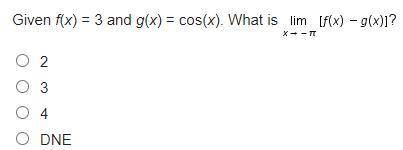
Mathematics, 19.05.2021 03:00 Sariyahhall1
Given f(x) = 3 and g(x) = cos(x). What is Limit of left-bracket f (x) minus g (x) right-bracket as x approaches negative pi?
2
3
4
DNE


Answers: 3


Other questions on the subject: Mathematics

Mathematics, 21.06.2019 14:30, christinafish9303
Which statement about the relative areas of ? abc and ? xyz is true? the area of ? abc > the area of ? xyz the area of ? abc < the area of ? xyz the area of ? abc = the area of ? xyz more information is needed to compare.
Answers: 2

Mathematics, 21.06.2019 20:00, proutyhaylee
Suppose a store sells an average of 80 cases of soda per day. assume that each case contains 24 cans of soda and that the store is open 10 hours per day. find the average number of soda that the store sells per hour.
Answers: 1

Mathematics, 21.06.2019 21:00, lunnar2003
Graph the system of inequalities presented here on your own paper, then use your graph to answer the following questions: y < 4x − 8 y is greater than or equal to negative 5 over 2 times x plus 5 part a: describe the graph of the system, including shading and the types of lines graphed. provide a description of the solution area. (6 points) part b: is the point (5, −8) included in the solution area for the system? justify your answer mathematically. (4 points)
Answers: 3
You know the right answer?
Given f(x) = 3 and g(x) = cos(x). What is Limit of left-bracket f (x) minus g (x) right-bracket as x...
Questions in other subjects:












